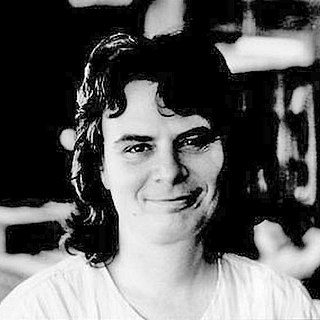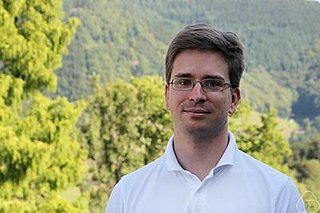Related Research Articles

Differential geometry is a mathematical discipline that studies the geometry of smooth shapes and smooth spaces, otherwise known as smooth manifolds. It uses the techniques of differential calculus, integral calculus, linear algebra and multilinear algebra. The field has its origins in the study of spherical geometry as far back as antiquity. It also relates to astronomy, the geodesy of the Earth, and later the study of hyperbolic geometry by Lobachevsky. The simplest examples of smooth spaces are the plane and space curves and surfaces in the three-dimensional Euclidean space, and the study of these shapes formed the basis for development of modern differential geometry during the 18th and 19th centuries.

In geometry, a geodesic is a curve representing in some sense the shortest path (arc) between two points in a surface, or more generally in a Riemannian manifold. The term also has meaning in any differentiable manifold with a connection. It is a generalization of the notion of a "straight line".
Riemannian geometry is the branch of differential geometry that studies Riemannian manifolds, defined as smooth manifolds with a Riemannian metric. This gives, in particular, local notions of angle, length of curves, surface area and volume. From those, some other global quantities can be derived by integrating local contributions.
In mathematics, the uniformization theorem states that every simply connected Riemann surface is conformally equivalent to one of three Riemann surfaces: the open unit disk, the complex plane, or the Riemann sphere. The theorem is a generalization of the Riemann mapping theorem from simply connected open subsets of the plane to arbitrary simply connected Riemann surfaces.

Eugenio Calabi was an Italian-born American mathematician and the Thomas A. Scott Professor of Mathematics at the University of Pennsylvania, specializing in differential geometry, partial differential equations and their applications.

Geometric analysis is a mathematical discipline where tools from differential equations, especially elliptic partial differential equations (PDEs), are used to establish new results in differential geometry and differential topology. The use of linear elliptic PDEs dates at least as far back as Hodge theory. More recently, it refers largely to the use of nonlinear partial differential equations to study geometric and topological properties of spaces, such as submanifolds of Euclidean space, Riemannian manifolds, and symplectic manifolds. This approach dates back to the work by Tibor Radó and Jesse Douglas on minimal surfaces, John Forbes Nash Jr. on isometric embeddings of Riemannian manifolds into Euclidean space, work by Louis Nirenberg on the Minkowski problem and the Weyl problem, and work by Aleksandr Danilovich Aleksandrov and Aleksei Pogorelov on convex hypersurfaces. In the 1980s fundamental contributions by Karen Uhlenbeck, Clifford Taubes, Shing-Tung Yau, Richard Schoen, and Richard Hamilton launched a particularly exciting and productive era of geometric analysis that continues to this day. A celebrated achievement was the solution to the Poincaré conjecture by Grigori Perelman, completing a program initiated and largely carried out by Richard Hamilton.

Karen Keskulla Uhlenbeck ForMemRS is an American mathematician and one of the founders of modern geometric analysis. She is a professor emeritus of mathematics at the University of Texas at Austin, where she held the Sid W. Richardson Foundation Regents Chair. She is currently a distinguished visiting professor at the Institute for Advanced Study and a visiting senior research scholar at Princeton University.

Jerrold Eldon Marsden was a Canadian mathematician. He was the Carl F. Braun Professor of Engineering and Control & Dynamical Systems at the California Institute of Technology. Marsden is listed as an ISI highly cited researcher.

Alan David Weinstein is a professor of mathematics at the University of California, Berkeley, working in the field of differential geometry, and especially in Poisson geometry.

Robert "Bob" Osserman was an American mathematician who worked in geometry. He is specially remembered for his work on the theory of minimal surfaces.

Leon Melvyn Simon, born in 1945, is a Leroy P. Steele Prize and Bôcher Prize-winning mathematician, known for deep contributions to the fields of geometric analysis, geometric measure theory, and partial differential equations. He is currently Professor Emeritus in the Mathematics Department at Stanford University.
Tobias Holck Colding is a Danish mathematician working on geometric analysis, and low-dimensional topology. He is the great grandchild of Ludwig August Colding.
Mathematics is a broad subject that is commonly divided in many areas that may be defined by their objects of study, by the used methods, or by both. For example, analytic number theory is a subarea of number theory devoted to the use of methods of analysis for the study of natural numbers.

Simon Brendle is a German-American mathematician working in differential geometry and nonlinear partial differential equations. He received his Dr. rer. nat. from Tübingen University under the supervision of Gerhard Huisken (2001). He was a professor at Stanford University (2005–2016), and is currently a professor at Columbia University. He has held visiting positions at MIT, ETH Zürich, Princeton University, and Cambridge University.
Robert C. Hermann was an American mathematician and mathematical physicist. In the 1960s Hermann worked on elementary particle physics and quantum field theory, and published books which revealed the interconnections between vector bundles on Riemannian manifolds and gauge theory in physics, before these interconnections became "common knowledge" among physicists in the 1970s.

Gerhard Huisken is a German mathematician whose research concerns differential geometry and partial differential equations. He is known for foundational contributions to the theory of the mean curvature flow, including Huisken's monotonicity formula, which is named after him. With Tom Ilmanen, he proved a version of the Riemannian Penrose inequality, which is a special case of the more general Penrose conjecture in general relativity.

Jürgen Jost is a German mathematician specializing in geometry. He has been a director of the Max Planck Institute for Mathematics in the Sciences in Leipzig since 1996.
In mathematics, global analysis, also called analysis on manifolds, is the study of the global and topological properties of differential equations on manifolds and vector bundles. Global analysis uses techniques in infinite-dimensional manifold theory and topological spaces of mappings to classify behaviors of differential equations, particularly nonlinear differential equations. These spaces can include singularities and hence catastrophe theory is a part of global analysis. Optimization problems, such as finding geodesics on Riemannian manifolds, can be solved using differential equations, so that the calculus of variations overlaps with global analysis. Global analysis finds application in physics in the study of dynamical systems and topological quantum field theory.
David Gregory Ebin is an American mathematician, specializing in differential geometry.
References
- ↑ information from American Men and Women of Science, Thomson Gale 2004
- ↑ Anthony Joseph Tromba at the Mathematics Genealogy Project
- 1 2 "Anthony J. Tromba". U. C. Santa Cruz Mathematics Department. Archived from the original on 2018-03-03. Retrieved 2018-03-02.
- ↑ Wolf, Michael (1993). "Review of Teichmüller theory in Riemannian geometry by Anthony J. Tromba". Bull. Amer. Math. Soc. (N.S.). 29: 285–290. doi: 10.1090/S0273-0979-1993-00421-X .
- ↑ Weber, Matthias (1 June 2010). "Review of Global Analysis of Minimal Surfaces by Ulrich Dierkes, Stefan Hildebrandt, and Anthony J. Tromba". MAA Reviews, Mathematical Association of America.
- ↑ Weber, Matthias (1 June 2010). "Review of Regularity of Minimal Surfaces by Ulrich Dierkes, Stefan Hildebrandt, and Anthony J. Tromba". MAA Reviews, Mathematical Association of America.